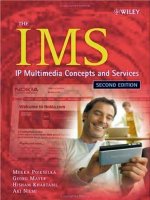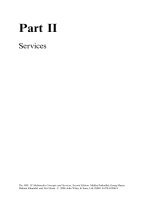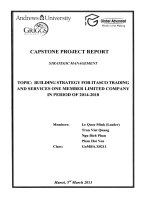Dessler HRM 12e ch 013 benifits and services
Bạn đang xem bản rút gọn của tài liệu. Xem và tải ngay bản đầy đủ của tài liệu tại đây (1.03 MB, 41 trang )
Chapter 13
Benefits
and Services
Part Four | Compensation
Copyright © 2011 Pearson Education, Inc.
publishing as Prentice Hall
PowerPoint Presentation by Charlie Cook
The University of West Alabama
WHERE WE ARE NOW…
Copyright © 2011 Pearson Education, Inc. publishing as Prentice Hall
13–2
LEARNING OUTCOMES
1. Name and define each of the main pay for time not
worked benefits.
2. Describe each of the main insurance benefits.
3. Discuss the main retirement benefits.
4. Outline the main employees’ services benefits.
5. Explain the main flexible benefit programs.
Copyright © 2011 Pearson Education, Inc. publishing as Prentice Hall
13–3
Benefits
Types of Employee Benefits
Supplemental
pay
Insurance
benefits
Copyright © 2011 Pearson Education, Inc. publishing as Prentice Hall
Retirement
benefits
Executive
services
13–4
FIGURE 13–1
U.S. Health Care Cost Increases*
Total Spending on Health Care
2004
2009
2015
Dollars
$1.9 trillion
$2.9 trillion
$4 trillion
% of GNP
16%
18%
20%
*Note: Figures for 2009 and 2015 estimated. Health care costs rose 7.9% in 2004,
about twice the rate of inflation, and are expected to rise at that rate through 2015.
Copyright © 2011 Pearson Education, Inc. publishing as Prentice Hall
13–5
FIGURE 13–2
Private-Sector Employer Benefits Costs by Category, March 2009
Copyright © 2011 Pearson Education, Inc. publishing as Prentice Hall
13–6
TABLE 13–1
Some Required and Discretionary Benefits
Benefits Required by Federal
or Most State Law
Benefits Discretionary
on Part of Employer*
Social Security
Disability, Health, and Life Insurance
Unemployment Insurance
Pensions
Workers’ Compensation
Paid Time Off for Vacations, Holidays, Sick
Leave, Personal Leave, Jury Duty, etc.
Leaves under the Family Medical
Leave Act
Employee Assistance and Counseling
Programs
“Family Friendly” benefits for Child Care,
Elder Care, Flexible Work Schedules, etc.
Executive Perquisites
* While not required under federal law, all these benefits are regulated
in some way by federal law, as explained in this chapter.
Copyright © 2011 Pearson Education, Inc. publishing as Prentice Hall
13–7
Policy Issues in Designing Benefit
Packages
Which benefits to offer
Who will be covered
Whether to include
retirees
Coverage during
probation
Policy Issues
How to finance benefits
Degree of employee
choice
Cost containment
procedures
Communicating
benefits options
Copyright © 2011 Pearson Education, Inc. publishing as Prentice Hall
13–8
Pay For Time Not Worked
Vacations and
holidays
Unemployment
insurance
Sick leave
Supplemental
Pay Benefits
Severance pay
Copyright © 2011 Pearson Education, Inc. publishing as Prentice Hall
Parental leave
Supplemental
unemployment
benefits
13–9
Pay for Time Not Worked
• Unemployment Insurance
Provides for benefits if a person is unable to work through
no fault of his or her own.
Is an employer payroll tax that is determined by an
employer’s rate of personnel terminations.
Tax is collected and administered by the state.
• Vacations and Holidays
Number of paid leave days and holidays varies by employer.
Qualification for and calculation of holiday and leave pay
varies by employer.
Premium pay for those who work on holidays.
Copyright © 2011 Pearson Education, Inc. publishing as Prentice Hall
13–10
TABLE 13–2
An Unemployment Insurance Cost-Control Checklist
Do You:
Keep documented history of lateness, absence, and warning notices
Warn chronically late employees before discharging them
Have rule that 3 days’ absence without calling in is reason for automatic discharge
Request doctor’s note on return to work after absence
Make written approval for personal leave mandatory
Stipulate date for return to work from leave
Obtain a signed resignation statement
Mail job abandonment letter if employee fails to return on time
Document all instances of poor performance
Require supervisors to document the steps taken to remedy the situation
Document employee’s refusal of advice and direction
Require all employees to sign a statement acknowledging acceptance of firm’s policies and rules
File the protest against a former employee’s unemployment claim on time (usually within 10 days)
Use proper terminology on claim form and attach documented evidence regarding separation
Attend hearings and appeal unwarranted claims
Check every claim against the individual’s personnel file
Routinely conduct exit interviews to produce information for protesting unemployment claims
Copyright © 2011 Pearson Education, Inc. publishing as Prentice Hall
13–11
Pay for Time Not Worked (cont’d)
• Sick Leave
Provides pay to an employee when he or she is out of work
because of illness.
Costs for misuse of sick leave
Pooled paid leave plans
• Parental Leave
The Family Medical Leave Act of 1993 (FMLA)
Up to 12 weeks of unpaid leave within a one-year period.
Employees must take unused paid leave first.
Employees on leave retain their health benefits.
Employees have right to return to job or equivalent position.
Copyright © 2011 Pearson Education, Inc. publishing as Prentice Hall
13–12
FIGURE 13–3
Your Rights Under
the Family and
Medical Leave Act
of 1993
Copyright © 2011 Pearson Education, Inc. publishing as Prentice Hall
13–13
FIGURE 13–4
Online Request
for Leave Form
Copyright © 2011 Pearson Education, Inc. publishing as Prentice Hall
13–14
Pay for Time Not Worked (cont’d)
• Severance Pay
A one-time payment when terminating an employee.
• Reasons for granting severance pay:
Acts as a humanitarian gesture and good public relations.
Mirrors employee’s two-week quit notice.
Avoids litigation from disgruntled former employees.
Reassures employees who stay on after the employer
downsizes its workforce of employer’s good intentions.
Copyright © 2011 Pearson Education, Inc. publishing as Prentice Hall
13–15
Pay for Time Not Worked (cont’d)
• Supplemental Unemployment Benefits (SUB)
Payments that supplement the laid-off or furloughed employee’s
unemployment compensation.
The employer makes contributions to a SUB reserve fund.
SUB payments are made to employees for the time the
employee is out of work due to layoffs, reduced workweeks,
or relocations.
SUB payments are considered previously earned
compensation for unemployment calculation purposes.
Copyright © 2011 Pearson Education, Inc. publishing as Prentice Hall
13–16
Insurance Benefits
• Workers’ Compensation
Provides income and medical benefits to work-related
accident victims or their dependents, regardless of fault.
Death or disability: a cash benefit based on earnings
per week of employment.
Specific loss injuries: statutory list of losses.
Injured workers are protected by ADA provisions.
Controlling workers’ compensation costs
Screen out accident-prone workers.
Make the workplace safer.
Thoroughly investigate accident claims.
Use case management to return injured employees to
work as soon as possible.
Copyright © 2011 Pearson Education, Inc. publishing as Prentice Hall
13–17
Insurance Benefits (cont’d)
• Hospitalization, Health, and Disability Insurance
Provide for loss of income protection and group-rate
coverage of basic and major medical expenses for
off-the-job accidents and illnesses.
Accidental death and dismemberment
Disability insurance
Mental health benefits
Copyright © 2011 Pearson Education, Inc. publishing as Prentice Hall
13–18
TABLE 13–3
Percentage of Employers Offering Popular Health Benefits—
Change Over Time
Yes (%) 2005
Yes (%) 2009
Prescription drug program coverage
97
96
Dental insurance
95
96
Mail order prescription program
90
91
PPO (preferred provider organization)
87
81
Chiropractic coverage
56
80
Mental health insurance
72
80
Vision insurance
80
76
Employee assistance program
73
75
Medical spending account
80
71
Life insurance for dependents
67
58
HMO (health maintenance organization)
53
35
Copyright © 2011 Pearson Education, Inc. publishing as Prentice Hall
13–19
Insurance Benefits (cont’d)
• Health Maintenance Organization (HMO)
A medical organization consisting of specialists
operating out of a health care center.
Provides routine medical services to employees
who pay a nominal fee.
Receives a fixed annual contract fee per employee
from the employer (or employer and employee),
regardless of whether it provides that person with
service.
Copyright © 2011 Pearson Education, Inc. publishing as Prentice Hall
13–20
Insurance Benefits (cont’d)
• Preferred Provider Organizations (PPOs)
Groups of health care providers that contract to provide
services at reduced fees.
Employees can select from a list of preferred individual
health providers.
Providers agree to discount services and to submit to
utilization controls.
Employees using non-PPO-listed providers may pay
all costs or only costs above the reduced fee structure
for services.
Copyright © 2011 Pearson Education, Inc. publishing as Prentice Hall
13–21
Laws Influencing Health Care
Benefits
• Health Services and Insurance
COBRA notification and insurance continuance requirements
Health Insurance Portability and Accountability Act of 1996
(HIPAA)
• Retirement and Pension Plans
Employee Retirement Income Security Act of 1974 (ERISA)
• Mental Health Benefits
Mental Health Parity Act of 1996
• Family Leave
Pregnancy Discrimination Act
Family Medical Leave Act
The Newborn Mother’s Protection Act of 1996
Copyright © 2011 Pearson Education, Inc. publishing as Prentice Hall
13–22
FIGURE 13–5
COBRA Record-Keeping
Compliance Checklist
Copyright © 2011 Pearson Education, Inc. publishing as Prentice Hall
13–23
Trends in Health Care Cost Controls
Premiums and co-pays
Communication and
empowerment
Cost-Control
Trends
Wellness programs
Health savings accounts
Claim audits
Copyright © 2011 Pearson Education, Inc. publishing as Prentice Hall
13–24
Other Cost-Control Options
Mandatory online plan
enrollment
Defined contribution
health care plans
Controlling
Health Care
Costs
Outsourced health care
plan administration
Reduced retiree
health care coverage
Benefits purchasing
alliances
Copyright © 2011 Pearson Education, Inc. publishing as Prentice Hall
13–25
![microsoft silverlight 5 data and services cookbook [electronic resource] over 100 practical recipes for creating rich, data-driven, business applications in silverlight 5](https://media.store123doc.com/images/document/14/y/ev/medium_neP7R4h80c.jpg)








